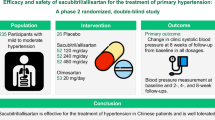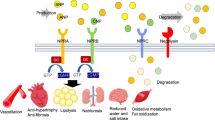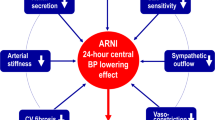Abstract
The new orally active angiotensin II (A II) type-1 receptor antagonist olmesartan medoxomil is a prodrug, which is rapidly converted in vivo to the active metabolite, olmesartan. The pharmacology, antihypertensive efficacy and safety of olmesartan medoxomil and/or the pharmacologically active metabolite, olmesartan, have been evaluated in both non-clinical and clinical models. Orally administered olmesartan medoxomil is rapidly absorbed from the gastrointestinal tract and converted during absorption to olmesartan, which is subsequently excreted without further metabolism. Peak plasma concentrations of olmesartan occur 1–3 h after administration, after which concentrations decrease with an elimination half-life of 10–15 h. The absolute bioavailability of olmesartan from olmesartan medoxomil tablets is 28.6%. In a single-dose crossover study in 16 patients with mild-to-moderate hypertension receiving a sodium-restricted diet, statistically significant lowering of mean 24-h blood pressure was seen at doses of 10–80 mg. Evaluation of 14 phase II/III studies has confirmed the antihypertensive efficacy of olmesartan medoxomil in over 3500 patients who received the drug for up to 2 years. Frequencies of adverse events during treatment with olmesartan medoxomil and placebo are similar, with no evidence of a dose response. There are no clinically significant effects on laboratory parameters, and the drug-interaction potential of olmesartan medoxomil is low. Current indications are that olmesartan medoxomil is a true once-daily, orally active A II antagonist with good antihypertensive efficacy and a favourable adverse-event profile. Clinical pharmaco- dynamic and efficacy studies support a usual dose of 20 mg once daily, increasing to 40 mg if needed.
This is a preview of subscription content, access via your institution
Access options
Subscribe to this journal
Receive 12 digital issues and online access to articles
$119.00 per year
only $9.92 per issue
Buy this article
- Purchase on Springer Link
- Instant access to full article PDF
Prices may be subject to local taxes which are calculated during checkout

Similar content being viewed by others
References
Brunner HR . Olmesartan medoxomil: a new AT1 receptor antagonist for the treatment of hypertension. Introduction J Hypertens 2001 19 (Suppl): S1–S2
Koike H, Sada T, Mizuno M . In vitro and in vivo pharmacology of olmesartan medoxomil, an angiotensin II type AT1 receptor antagonist J Hypertens 2001 19 (Suppl): S3–S14
Laeis P, Püchler K, Kirch W . The pharmacokinetic and metabolic profile of olmesartan medoxomil limits the risk of clinically relevant drug interaction J Hypertens 2001 19 (Suppl): S21–S32
von Bergmann K et al. Olmesartan medoxomil: influence of age, renal and hepatic function on the pharmacokinetics of olmesartan medoxomil J Hypertens 2001 19 (Suppl): S33–S40
Püchler K, Nussberger J, Laeis P, Witte P-U . Blood pressure and endocrine effects of single doses of CS-866, a novel angiotensin II antagonist in salt-restricted hypertensivepatients J Hypertens 1997 15: 1809–1812
Brunner HR, Nussberger J . Relevance of clinical pharmacological models for the evaluation of the therapeutic dose range of an AT1 receptor antagonist J Hypertens 2001 19 (Suppl): S15–S20
Püchler K, Laeis P, Stumpe KO . Blood pressure response, but not adverse event incidence, correlates with dose of angiotensin II antagonist J Hypertens 2001 19 (Suppl): S41–S48
Data on file, Sankyo. Study 866–305
Püchler K, Laeis P, Stumpe KO . Dose related differences in blood pressure response are not related to adverse event incidence [poster] ESH 11th European meeting on Hypertension, Milan, Italy, June 2001
Author information
Authors and Affiliations
Corresponding author
Rights and permissions
About this article
Cite this article
Brunner, H. The new oral angiotensin II antagonist olmesartan medoxomil: a concise overview. J Hum Hypertens 16 (Suppl 2), S13–S16 (2002). https://doi.org/10.1038/sj.jhh.1001391
Published:
Issue Date:
DOI: https://doi.org/10.1038/sj.jhh.1001391
Keywords
This article is cited by
-
A comprehensive review on invasomal carriers incorporating natural terpenes for augmented transdermal delivery
Future Journal of Pharmaceutical Sciences (2022)
-
Box Behnken Design-Enabled Development of Nanostructured Lipid Carrier Transdermal Patch for Enhancement of Bioavailability of Olmesartan Medoxomil
Journal of Pharmaceutical Innovation (2022)
-
In silico assessment of chronic toxicity of a combination drug namely ‘Olmesartan medoxomil and Hydrochlorothiazide’, marketed in Bangladesh
Future Journal of Pharmaceutical Sciences (2021)
-
Efficacy and safety of azilsartan medoxomil, an angiotensin receptor blocker, in Korean patients with essential hypertension
Clinical Hypertension (2018)
-
Formulation, optimization, and in vitro–in vivo evaluation of olmesartan medoxomil nanocrystals
Drug Delivery and Translational Research (2017)



